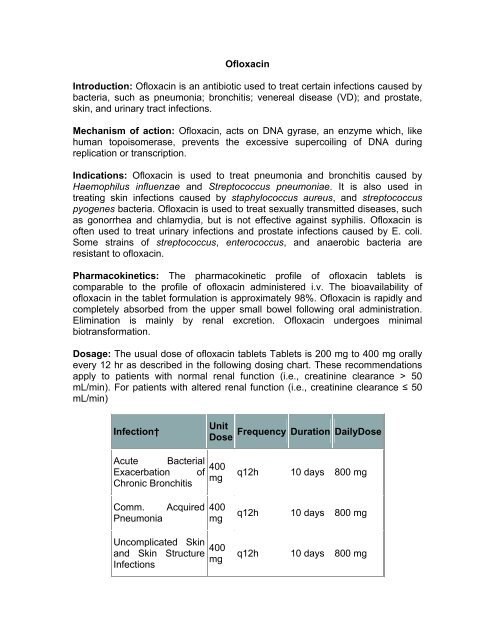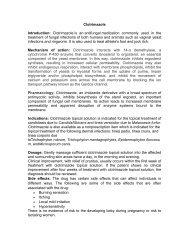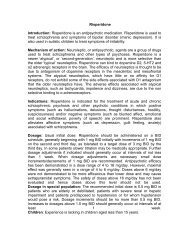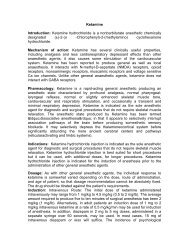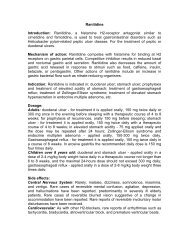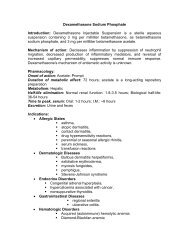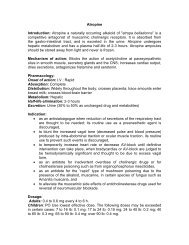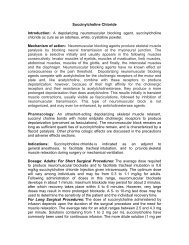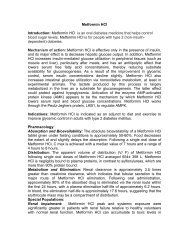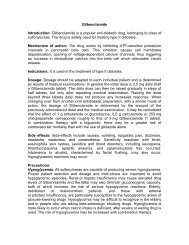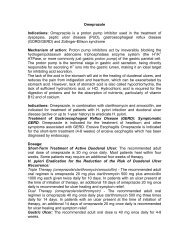Ofloxacin - Pharma Manufacturer
Ofloxacin - Pharma Manufacturer
Ofloxacin - Pharma Manufacturer
You also want an ePaper? Increase the reach of your titles
YUMPU automatically turns print PDFs into web optimized ePapers that Google loves.
<strong>Ofloxacin</strong>Introduction: <strong>Ofloxacin</strong> is an antibiotic used to treat certain infections caused bybacteria, such as pneumonia; bronchitis; venereal disease (VD); and prostate,skin, and urinary tract infections.Mechanism of action: <strong>Ofloxacin</strong>, acts on DNA gyrase, an enzyme which, likehuman topoisomerase, prevents the excessive supercoiling of DNA duringreplication or transcription.Indications: <strong>Ofloxacin</strong> is used to treat pneumonia and bronchitis caused byHaemophilus influenzae and Streptococcus pneumoniae. It is also used intreating skin infections caused by staphylococcus aureus, and streptococcuspyogenes bacteria. <strong>Ofloxacin</strong> is used to treat sexually transmitted diseases, suchas gonorrhea and chlamydia, but is not effective against syphilis. <strong>Ofloxacin</strong> isoften used to treat urinary infections and prostate infections caused by E. coli.Some strains of streptococcus, enterococcus, and anaerobic bacteria areresistant to ofloxacin.<strong>Pharma</strong>cokinetics: The pharmacokinetic profile of ofloxacin tablets iscomparable to the profile of ofloxacin administered i.v. The bioavailability ofofloxacin in the tablet formulation is approximately 98%. <strong>Ofloxacin</strong> is rapidly andcompletely absorbed from the upper small bowel following oral administration.Elimination is mainly by renal excretion. <strong>Ofloxacin</strong> undergoes minimalbiotransformation.Dosage: The usual dose of ofloxacin tablets Tablets is 200 mg to 400 mg orallyevery 12 hr as described in the following dosing chart. These recommendationsapply to patients with normal renal function (i.e., creatinine clearance > 50mL/min). For patients with altered renal function (i.e., creatinine clearance ≤ 50mL/min)Infection†UnitDoseFrequency Duration DailyDoseAcute BacterialExacerbation ofChronic Bronchitis400mgq12h 10 days 800 mgComm.PneumoniaAcquired400mgq12h 10 days 800 mgUncomplicated Skinand Skin StructureInfections400mgq12h 10 days 800 mg
Acute,UncomplicatedUrethral and CervicalGonorrhea400mgsingledose1 day 400 mgNongonococcalCervicitis/Urethritisdue to C.trachomatisMixed Infection ofthe urethra andcervix due to C.trachomatis and N.gonorrhoeae300mg300mgq12h 7 days 600 mgq12h 7 days 600 mgAcuteInflammatoryDiseasePelvic400mgq12h10-14days800 mgUncomplicatedCystitis due to E. colior K. pneumoniaeUncomplicatedCystitis due to otherapproved pathogens200mg200mgq12h 3 days 400 mgq12h 7 days 400 mgComplicated UTI's200mgq12h 10 days 400 mgProstatitis due toE.Coli300mgq12h6 weeks 600 mgPatients with Impaired Renal Function: Dosage should be adjusted forpatients with a creatinine clearance < 50 mL/min. After a normal initial dose,dosage should be adjusted as follows:Creatinine ClearanceMaintenanceDoseFrequency20-50 mL/minthe usualrecommended q24hunit dose
20 mL/min½ the usualrecommendedunit doseq24hPatients with Cirrhosis: The excretion of ofloxacin may be reduced in patientswith severe liver function disorders (e.g., cirrhosis with or without ascites). Amaximum dose of 400 mg of ofloxacin per day should therefore not be exceeded.Side effects: The most frequent side effects include nausea, vomiting, diarrhea,insomnia, headache, dizziness, itching, and vaginitis in women. Rare allergicreactions have been described, such as hives and anaphylaxis (shock).Symptoms of nervous system stimulation, such as anxiety, euphoria, andhallucinations have rarely been reported.Precautions:General: Periodic assessment of organ system functions, including renal,hepatic and hematopoietic, is advisable during prolonged therapy. Adequatehydration of patients receiving ofloxacin should be maintained to prevent theformation of highly concentrated urine.Renal/Hepatic: Administer ofloxacin with caution in the presence of renal orhepatic insufficiency/impairment. In patients with known or suspected renal orhepatic insufficiency/impairment, careful clinical observation and appropriatelaboratory studies should be performed prior to and during therapy sinceelimination of ofloxacin may be reduced. Alteration of the dosage regimen isnecessary for patients with impairment of renal function (creatinine clearance £50mL/min).Allergic Reactions: Moderate to severe phototoxicity reactions have beenobserved in patients who are exposed to direct sunlight while receiving somedrugs in this class including ofloxacin. Excessive sunlight should be avoided.Therapy should be discontinued if phototoxicity (e.g., a skin eruption, etc.)occurs.Pregnancy: Safety and efficacy have not been established in pregnant women.<strong>Ofloxacin</strong> should not be used during pregnancy unless the potential benefitjustifies the potential risk to the fetus.Children: Safety and effectiveness in children and adolescents below the age of18 years have not been established. <strong>Ofloxacin</strong> causes arthropathy (arthrosis)and osteochondrosis in juvenile animals of several species.Patients with Special Diseases and Conditions:CNS Disorders: As with all quinolones, ofloxacin should be used with caution inany patient with a known or suspected CNS disorder that may predispose toseizures or lower the seizure threshold (e.g., severe cerebral arteriosclerosis,epilepsy, etc.) or in the presence of other risk factors that may predispose toseizures or lower the seizure threshold (e.g., certain drug therapy, renal
dysfunction, etc.).Contraindications: <strong>Ofloxacin</strong> Tablets is contraindicated in persons with a historyof hypersensitivity associated with the use of ofloxacin or any member of thequinolone group of antimicrobial agents.How supplied: Customized as per request.


